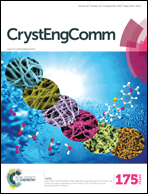Watson–Crick base pairing in 9-methyladenine and ethylene-9,9′-diadenine structures with close to 70% solvent content†
Abstract
In small organic molecules with adenine (A) moieties the nucleobases usually form hydrogen-bonded A![[double bond, length as m-dash]](https://www.rsc.org/images/entities/char_e001.gif) A
A![[double bond, length as m-dash]](https://www.rsc.org/images/entities/char_e001.gif) A tapes with trans Watson–Crick/Hoogsteen base pairs. In the crystal structure of ethylene-9,9′-diadenine tetra-1,1,1,3,3,3-hexafluoro-2-propanol solvate presented here, the hydroxyl group of the co-crystallized solvent molecules replaces the adenine –NH2 group as donor for the attractive N7 acceptor, leading instead to a highly solvated structure with less common trans Watson–Crick/Watson–Crick base pairs. The properties of hexafluoro-2-propanol as a hydrogen bond pattern modifier was subsequently demonstrated by using it as a crystallization solvent for 9-methyladenine, yielding a structure with the same hydrogen bonds and solvent content as the diadenine analogue.
A tapes with trans Watson–Crick/Hoogsteen base pairs. In the crystal structure of ethylene-9,9′-diadenine tetra-1,1,1,3,3,3-hexafluoro-2-propanol solvate presented here, the hydroxyl group of the co-crystallized solvent molecules replaces the adenine –NH2 group as donor for the attractive N7 acceptor, leading instead to a highly solvated structure with less common trans Watson–Crick/Watson–Crick base pairs. The properties of hexafluoro-2-propanol as a hydrogen bond pattern modifier was subsequently demonstrated by using it as a crystallization solvent for 9-methyladenine, yielding a structure with the same hydrogen bonds and solvent content as the diadenine analogue.


 Please wait while we load your content...
Please wait while we load your content...